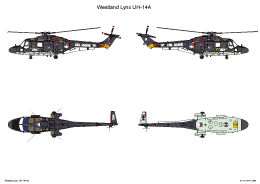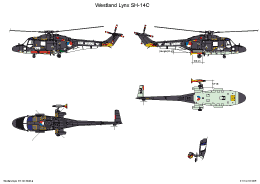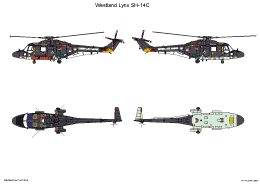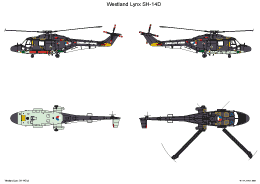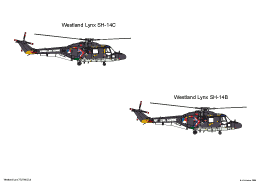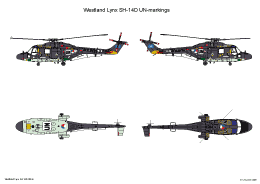History.
Development.
In the sixties, in response to helicopter specifications of the British and French army, Westland and Aerospatiale started a joint development of a helicopter in three variants (one light, one medium and one heavy duty).
Westland developed the medium variant, the WG.13, the forerunner of the Westland Lynx, while Aerospatiale developed heavy and a light version, known as the Puma and Gazelle.
The WG.13 was first shown, in mock-up form, at the Paris Air Show in 1970.
The first prototype first flew on March 21, 1971. Later four additional prototypes were built for testing purposes.
The first deliveries took place in 1977. The project was delayed by problems encountered with Rolls-Royce engines. The first Lynx, a military variant, was identified as Lynx AH.1. This was once the basis for the later versions of Lynx.
The AH.1 was a conventional design with a four-bladed main rotor and tail rotor and as power units two Rolls Royce GEM 2 turbines of 670 KW each were installed.
The AH.I had a ski under carriage, and had, besides the two doors for the cockpit, two fairly large sliding doors on both sides of the fuselage. Besides the two-man crew ten to twelve men could be taken. As cargo three stretchers (with a medic) or 900 kg internal or 1360 kg to the sling could be taken. Furthermore, it was possible to add to both sides a 7.63 machine gun in the doorways.
| Dimensions: | |||
| Diameter main rotor | 12,8 m | Diameter tail rotor | 2,21 m |
| Length without rotor | 12,06 m | Length with rotor | 15,16 m |
| Height (at tail rotor) | 3.66 m | Height (at main rotor) | 2.96 m |
| Weights: | |||
| Empty weight | 2.785 kg | Max weight | 4.535 kg |
| Performance: | |||
| Max. speed | 250 km/u | Service ceiling | 3.230 m |
| Range | 540 km | ||
A total of 113 machines was delivered to the British Army and the Marines.
The Lynx was a very pleasant experience to fly and was also very agile, not least thanks to the newly designed rotor head.
Early eighties, 60 aircraft modified to use the U.S. Hughes TOW wire-guided anti-tank missile. These were called Lynx AH.1 TOW.
On aircraft was used as a test device for testing with a 20 mm cannon and Stinger AAM. There was also an attempt was made to break the speed record for helicopters. The aircraft was equipped with the newly developed BERP (= British Experimental Rotor Programme) rotor, which was entirely of plastic and had some bent and wider ends and the new GEM 60 RR engine rated 940 kW. This Lynx had an average speed of over 400 km/h
Upon delivery of the Lynx AH.1 followed an order for five AH.5s, which, for evaluation had to be fitted with another engine, the Rolls-Royce GEM 41-1 rated 835 kW, fitted on the first three AH.5s or Rolls Royce GEM-42, also of 835 kW, fitted to the last two AH.5s, and an improved and strengthened transmission system.
Evaluations of the AH.5 led to the Lynx AH.7 production version, which was equipped with the GEM 42 turbine. Also the diameter of the tail rotor made of composite, was increased to 2,36 m, the tail was modified and the airframe was strengthened and provisions were made to be able to add a so-called "Hay Box" at the outlets (a provision to mislead heat-seeking missiles), the seats were armoured with kevlar and avionics was improved.
Eventually, ten newly built aircraft (including the original six AH.5s), yet a further 107 AH.1s converted. Later were also other changes such as the aforementioned BERP rotor.
An successor of the Lynx was the Lynx 3, a more sophisticated and heavier version. It was developed as a candidate for an attack helicopter for the French and German army. It included a revised, thicker tail boom, Rolls Royce 60-3/1 GEM motors of 940 kW each, an enlarged fuselage and a tricycle undercarriage. Unfortunately for Westland was chosen for the Eurocopter Tiger and the development was stopped.
The Lynx Mark 9 was another variant, in fact an improved Lynx AH.7 in which some developments of Lynx 3 were included. This type was equipped with a wheel undercarriage, a provision for infra-red heat protection from the exhaust and the BERP-rotor blades.
There were 16 new aircraft ordered, while another 8 Lynx AH.7 's were converted. Later, the banks were replaced by chairs, disadvantage of this safer situation was that less passengers could be taken. A disadvantage of the modified landing gear was a special aid should be added for dropping troops, also the TOW facility could not be applied.
Marine version HAS Mk.2
Parallel to the development of the Army versions was the development of a version for the Navy, HAS.Mk. 2. This type was meant to succeed the smaller Westland Wasp. The first flight of the HAS.2 was in February 1976.
This variant had the same engines as the AH.1, the tail unit could be folded, it was fitted with a wheel base, clings to the deck, inflatable floats attached on the two main wheel bins and a Ferranti Seaspray radar in the nose.
Furthermore it could carry torpedoes, depth charges and such entrainment. For submarine warfare a towed MAD could be added.
| Dimensions: | |||
| Diameter main rotor | 12,8 m | Diameter tail rotor | 2,21 m |
| Dimensions: | |||
| Fuselage length | 11,92 m | Length incl. main rotor | 15,16 m |
| Height (at tailrotor) | 3,60 m | Height (at main rotor) | 2,96 m |
| Weight: | |||
| Empty weight | 3345 kg | Max weight | 4765 kg |
| Performance: | |||
| Max. speed | 230 km/h | ||
| Service ceiling | 2575 m | Range | 95 km |
The British Navy ordered 60 aircraft.
For export reasons several other variants were developed, below an overview of these types:
- Westland Lynx Mark 2 (FN):
- for the (French) Aeronavale. This differed with the British version with regard to the radar, an Alcatel-4B DUAV dunking sonar instead of MAD and a provision for a hoist.
- Westland Lynx Mk. 21:
- nine examples for Brasil
- >Westland Lynx Mk. 23:
- two examples for Argentina
- Westland Lynx Mk. 25:
- The RNlNAS bought six machines of type Mk. 25. These were to be used for SAR, training and utility purposes. They were designated UH-14A and were delivered between 1976 and 1978.
- Westland Lynx Mk.27:
- The RNlNAS bought later ten Lynx Mk. 27s, designation SH-14B. These aircraft were delivered between 1978 and 1979. These aircraft were equipped with the more powerful GEM RR 4 Mk. 1010 engines of 836 hp; Alcatel-4A DUAV dunking sonar, and two Mk. 46 homing torpedoes.<
- Westland Lynx Mk. 66:
- Norway bought six Lynx Mk.86, which were delivered early eighties.
These aircraft were equipped with the Mark 4 1010 GEM RR engines, had equipment for flares, but were unarmed and the tail could not be folded.
However, the Seaspray radar was installed, and also a hoist and a camera.
Lynx HAS Mk.3
Soon after the HAS.2 its successor the HAS.3 was introduced.
This model had a stronger RR Gem 42-1 engines from 836 kW Mark 204 each, also the gearbox was adapted to transfer the increased power.
The number of floats was also increased from two to four, facilities for the installation of MAD and for the Orange Crop ESM with the necessary antennas under the tail.
23 units were delivered between 1982 and 1985. Furthermore, 53 HAS. 2 were upgraded.
Seven customized Lynx HAS.3 equipped with a secure radio system were delivered as HAS.3S.
Later, the machine were are adapted and equipped with a GPS system, FLIR and a chaff-flare plant.
Export versions of the HAS.3
- Westland Lynx Mark 4 (FN):
- France bought 14 "Lynx Mark 4 (FN)" with the improved engines and transmission of the Lynx HAS.3, but with the same avionics as the older machine of Aeronavale.
- Westland Lynx Mk. 80:
- for Argentina, but because of the Falklands war never delivered. These devices were adapted to the Danish specifications.
The Danish Lynxes were unarmed, but with Seapray radar, the tail could not be folded.
Two GEM RR 2 Mk. 1001 of 670 kW each were installed, later replaced by the more powerful RR Gem 42-1 Mk 204, as already installed on the Mk. 90; also, the transmission was changed.
Early 1990 machines were upgraded to seeing GPS, a data link, Orange Reaper RWR, Racal Kestrel ESM and FLIR.
These were designated Westland Lynx Mark 80A and Mark 90A respectively.
Later, a second upgrade followed to Super Lynx standard, under the designation Lynx Mk. 90B - Westland Lynx Mk. 81:
- Early eighties, the Dutch MLD purchased another eight Lynx Mark 81s, called SH-14C.
These aircraft were fitted with Rolls Royce GEM41 engines and an improved. They were equipped with a towed MAD type AN/ASQ-81. - Westland Lynx Mk. 88:
- The German Navy bought early eighties 19 Lynx Mark 88's. These were practically identical to the HAS.3, except that the tail could not be folded and also lacked the Bendix AN/ASQ-18 (v) dipping sonar.
Later the aircraft were upgraded to Super Lynx Standard.< - Westland Lynx Mk. 89:
- Nigeria bought three Lynx Mark 89, equipped with Rolls Royce Gem 43-1 Mark 1020 engines, each 847 kW (1,135 SHP) and digital control of fuel supply, Bendix Primus 500 radar and a folding tail.
LYNX HMA.8
Parallel with the Lynx 3 also a naval variant was developed. Since there were no orders for this type, the development was eventually stopped.
However, a third generation was set up under the name Lynx HMA 8 Lynx, which accommodated some elements of the Lynx 3.
The Lynx HMA 8 was in fact a naval version of the Lynx AH.7 and had the Rolls Royce Gem 42 series 200 engines of 686 kW, BERP-rotor blades, enlarged tail rotor with composite blades.
The HMA 8 had a housing under the nose containing the Seaspray radar Mk 3, although for financial reasons the older Seaspray Mk 1 radar was also used in the same enclosure. There was a turret under the nose containing the Sea Owl electro-optic "Passive Identification Device (PID) and also there were also further improvements.
Ultimately, no new HMA 8 built, but existing mainly HMA.3 machines were converted to the new standard.
| Dimensions: | |||
| Length with rotor | 12 m | Rotor diameter: | 12,8 m |
| Height: | 3,6 m | Diameter tail rotor | - m |
| Weights: | |||
| Empty weight | - kg | Max. start weight | - kg |
| Performance: | |||
| Max. speed | 320 km/u | cruising speed: | 230 km/u |
| Range: | 590 km | Service ceiling: | - m |
| Miscellaneous: | |||
| Engine type: | Two Rolls Royce GEM 42 rated 500 kW each | ||
| Crew: | Three men. | ||
| Armament: | |||
| Dimensions: | |||
| Length with rotor | 12 m | Rotor diameter: | 12,8 m |
| Height: | 3,6 m | Diameter tail rotor | - m |
| Weights: | |||
| Empty weight | - kg | Max. start weight | - kg |
| Performance: | |||
| Max. speed | 320 km/u | cruising speed: | 230 km/u |
| Range: | 590 km | Service ceiling: | - m |
| Miscellaneous: | |||
| Engine type: | Two Rolls Royce GEM FR4RR rated 1120 hp each | ||
| Crew: | Three men | ||
| Armament: | |||
| Dimensions: | |||
| Length with rotor | 12 m | Rotor diameter: | 12,8 m |
| Height: | 3,6 m | Diameter tail rotor | - m |
| Weights: | |||
| Empty weight | - kg | Max. start weight | - kg |
| Performance: | |||
| Max. speed | 320 km/u | cruising speed: | 230 km/u |
| Range: | 590 km | Service ceiling: | - m |
| Miscellaneous: | |||
| Engine type: | Two Rolls Royce GEM FR4RR rated 1120 hp each | ||
| Crew: | Three men. | ||
| Armament: | |||
| Dimensions: | |||
| Length with rotor | 12 m | Rotor diameter: | 12,8 m |
| Height: | 3,6 m | Diameter tail rotor | - m |
| Weights: | |||
| Empty weight | - kg | Max. start weight | - kg |
| Performance: | |||
| Max. speed | 320 km/u | cruising speed: | 230 km/u |
| Range: | 590 km | Service ceiling: | - m |
| Miscellaneous: | |||
| Engine type: | Two Rolls Royce GEM FR4R rated 1120 hp each | ||
| Crew: | Three men. | ||
| Armament: | 2 torpedoes, 1 machine-gun 7,62 mm, Dipping-sonar, radar, FLIR (Forward Looking Infra-Red) | ||
In 1977 the first Westland UH-14A Lynx entered Dutch service.
The Lynx replaced the Agusta-Bell 204 (I) UH-1& and was the lighter "Land 'version, the UH-14A, of which six were purchased. It was equipped with radar and could carry torpedoes.
Main task of this type was training, transportation and OSRD duties.
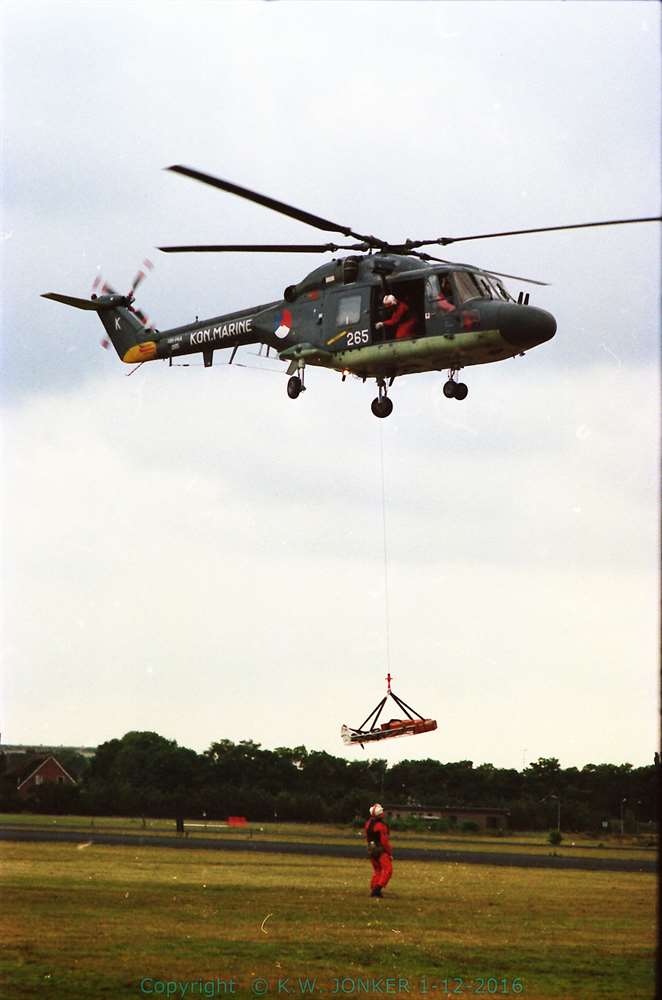
Westland UH-14A Lynx 265 performing a rescue demo during the Open Day Dutch Air Force, September 1984 at airbase Soesterberg.
The first aircraft were originally assigned to ;the British no 700 squadron in September 1976 based at RNAS Yeovilton.
This squadron had an assessment task.
39 Dutch crew members were trained and th e two Dutch machines were the 260 and 261.
In May 1977 the Dutch contribution was terminated and the two aircraft were transferred to De Kooy.
No 700 squadron was disbanded in December of that year.
The UH-14A was assigned to VSQ 7 at Naval Air Station De Kooy in Den Helder.
In 1979, the first ASW entered service, Lynx Mk.27,under the designation SH-14B.
This, heavier version was equipped with an active Alcatal DUAV-4A sonar and was (at that tim e the only helicopter type ) suited for single pilot operations.
The (SH-14B) Lynx is in fact equipped with AFCS (Automatic Flight Control System =).
This stabilization system maintains the set height and automatic support of the pilot and is especially helpful in SONAR operations.
The AFCS is supported by the Doppler radar for the horizontal positioning. A disadvantage of Doppler is that it does not work under smooth sea conditions.
<
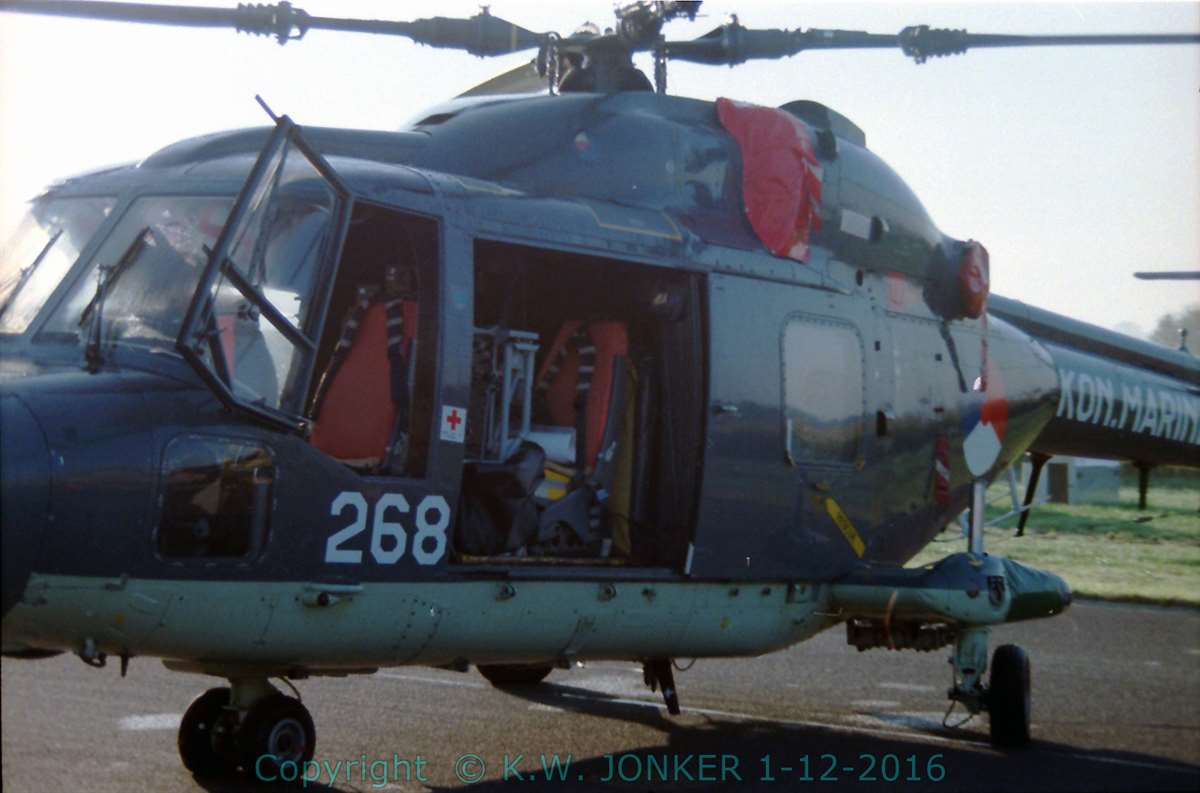
Westland UH-14B Lynx 268 at the Static Show at the Open Day Dutch Air Force, July 1986 at airbase Eindhoven.
p>This is why the later Phalanx version of the Dutch Lynx was equipped with GPS.
The SH-14B, of which ten were ordered and assigned to VSQ 860, was intended as a flight helicopter for the new S-frigates and succeeded the Westland Wasp UH-12 helicopters.
The sonar was mounted under the fuselage.
A significant difference with the UH-14A Lynx was also the more powerful engine and transmission. The undercarriage was also stronger
Later eight additional Lynx Mk.81, Dutch designation SH-14C, were purchased. These were equipped with a Texas Instruments AN/ASQ-81 (V) 2 MAD system and also had a different engine than the two previous versions. The MAD system was attached to the sponson at the right side.
This Magnetic Anomaly Detection System can detect submarines by disturbances in the earth's magnetic field. The Lockheed Orion was also equipped with this system.
To actually detect a submarine it is necessary to fly more or less directly over the submarine. The Dutch Navy had in mind to do this with passive sonobuoys or have the SH-14B and SH-14C operate in pairs.
Initially a fourth type of the Lynx would be purchased, but due to the progression of the attack techniques of the submarines and the missiles being fired from a larger distance, this fourth type never entered Dutch service. The Lynx also had a too limited flying range and also, because the system in practice turned out to be disappointing in practice, the MAD was removed mid-eighties.
Five SH-14C's were provided with equipment or the installation of a sonar system as was available in the SH-14B.
All three types could be fitted with a hoist, the UH-14A was this at the back of the doorway, the other two types the hoist was situated at the front.
For safety, the Lynx was equipped with two floatation gears mounted on the sponsons.
In May 1979 the so-called BET (board lynx Evaluation and Test Group) was established for testing and evaluation of the Westland Lynx. This team was aimed at all limits of the Lynx helicopter on board when used as fixed. In May 1980 the first Lynx SH-14B made a deck landing on a Dutch naval frigate.
Technical problems.
The Lynx is designed as a fast and highly manoeuvrable helicopter. This agility was needed to be able to avoid anti aircraft arms and to manoeuvre between the often swinging ships. The rotor system has a rigid construction because of this necessity.
A major drawback is that vibrations are passed to the other parts of the system, thus causing many problems with the electronic equipment. Initially, these electronics were replaced, but after some time, good equipment became available to properly balance the blades and so the vibration problem was solved.
Another problem was a logistical and technical one and was a direct result of using three different version and in particular the different types of engines used.
It also happened that large differences in flying hours per type emerged. The UH-14A, with a transportation and training function made a lot of flying hours, whereas the SH-14B an -C versions made much less hours.
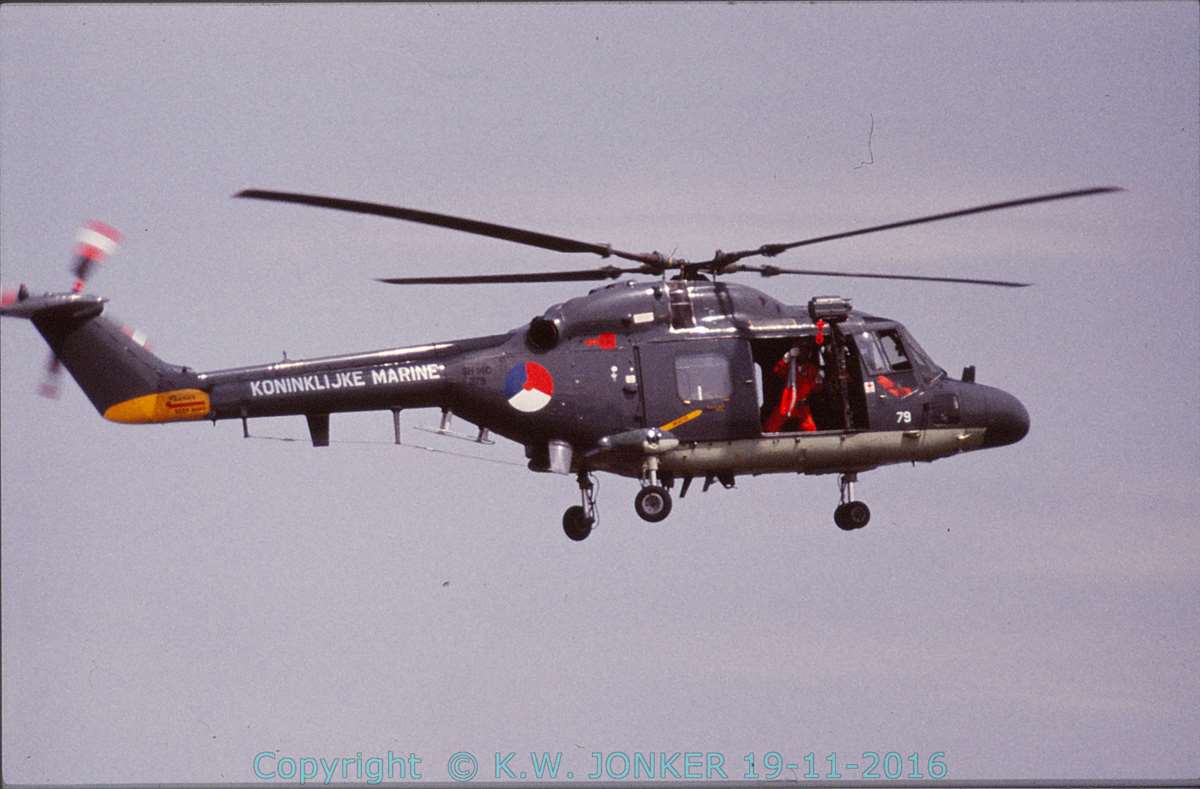
A Westland SH-14C, 279 with 'toned down' markings, photographed during Airshow 75 Years RNlAS, June 1992 at air station Valkenburg.
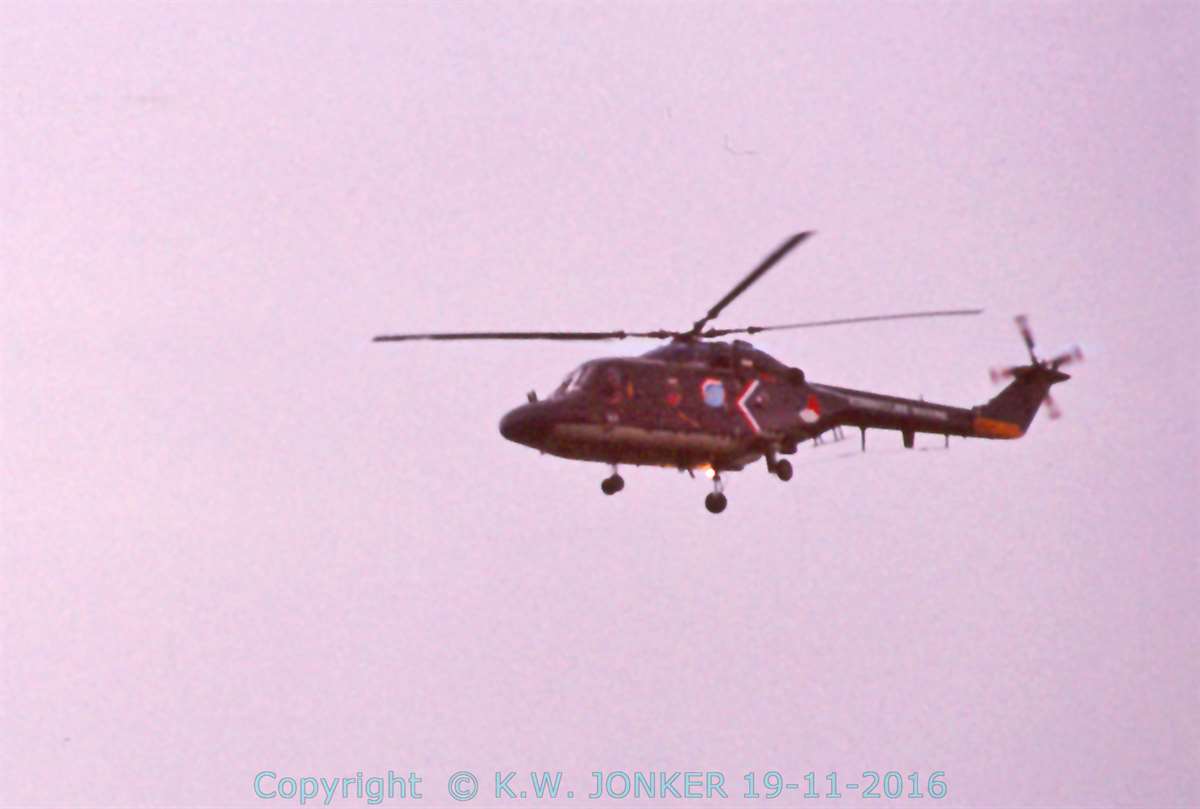
Een Westland Lynx met jubileum kenmerken, photographed during Airshow 75 Years RNlAS, June 1992 at air station Valkenburg.
Detachments.
In 2000 two aircraft, Lynx 278 and 264 prepared for an UN mission in Eritrea. They had a light armour and UN markings. They were between November 2000 and June 2001 in Eritrea. They were not equipped with a UN serial number.
In November 2003, again two aircraft, this time Lynx 277 and 276, were sent to Liberia. Later Lynx 270 was sent as a replacement. In April 2004 the aircraft returned.
They were given a UN-assigned serial number, 277 was UN 151 and Lynx 276 was UN 152.
The tail had the UN flag applied and the UN serial number with the text UNITED NATIONS on a white surface on the tail boom and just before the roundel on the fuselage a large square white surface with marking UN was applied.
Modifications.
In more than thirty years that the Westland Lynx has been in Dutch service, several modifications has been applied.
The SH-14B / C had originally a small VHF/UHF antenna under the tail. Later this was replaced with the larger antenna as the UH-14A already had.
PHALANX
In the summer of 1990 the (first) Gulf war started. The Netherlands sent as support some warships with a number of Lynx helicopters.
The frigates Hr. MS Pieter Floris, with two Lynx helicopters, the 268 and 283 on board and Mr. MS Witte de With, an air defence frigate, were sent. The marines aboard used the hoist to get aboard ships, which happened to be a time consuming and difficult job. After some time, the "fast-rope" system already used by the English navy , was tested and later used.
One problem was the heat of about 38 °C, causing the engines to deliver more than 20% less power.
Based on the experience two other aircraft, the 274 and 280 were adapted and made more suitable for Anti-Surface Warfare. These aircraft were aboard Mr. MS Philips Almonde from mid November 1991.
For example, a GPS (Trimpock .13210-0). arranged, recognizable by the white cap mid-tail and a FLIR System Model 2000A below the left doorway and a Dalma Victor AN/APR-39 RWR (Radar Warning Receiver) (the antenna on the nose and the antenna in the white fuselage roundel) were added.
Furthermore, a MAG 7.62 mm machine gun was mounted in the right doorway.
For a landing of marines was the fast rope system was installed.
Later a Ferranti AWARE-3 was also added.
Other aircraft had also a Chaff flare dispenser and M130 mounted under the tail, e.g. SH-14B 268.
STAMOL (Standaardisatie en Modernisering Lynx = Standardization and Modernization Lynx).
Due to the problems regarding the flight hours and maintenance problems it was decided to upgrade the Lynx to a standard type: the so-called STAMOL project. This project ran from 1991 to 1993
From 1994 the rotor blades replaced by the aforementioned BERP blades.
The first step was the standardization of the engines and Rolls-Royce Gem 42 turbines were installed.
Further more were sixteen aircraft equipped with the Alcatel Dipping Sonar, the remaining six aircraft had just the facilities built in.
Also, an UHF radio system, RWR, FLIR Systems Inc. 2000HP FLIR, a Trimble 2200 GPS and a new type radar altimeter were installed.
No changes were made such as with the British Lynx HMA.8, e.g the Dutch Lynx kept its original tail rotor.
Mid nineties the Dutch Lynx was equipped with the new plastic main rotor blades, the so-called "CMRBs" = Composite Main Rotor Blades.
Westland stopped manufacturing the original, metal blades and provided only the CMRB. These blades, also referred to as "BERP" (British Experimental Rotor Programme BERP =), can be identified by the widened, slightly curved end.
In case of applying these blades Westland prescribed to modify the horizontal tailplane. Approximately 45 cm was removed and the trailing edge was provided with a raised edge, "Gurney flap" of about 2 cm.

A Westland SH-14D, 264 photographed during an Open Day Dutch Air Force, June 2007 at airbase Volkel.

A Westland SH-14D, 271 photographed during an Open Day Dutch Air Force, June 2003 at airbase Twenthe.
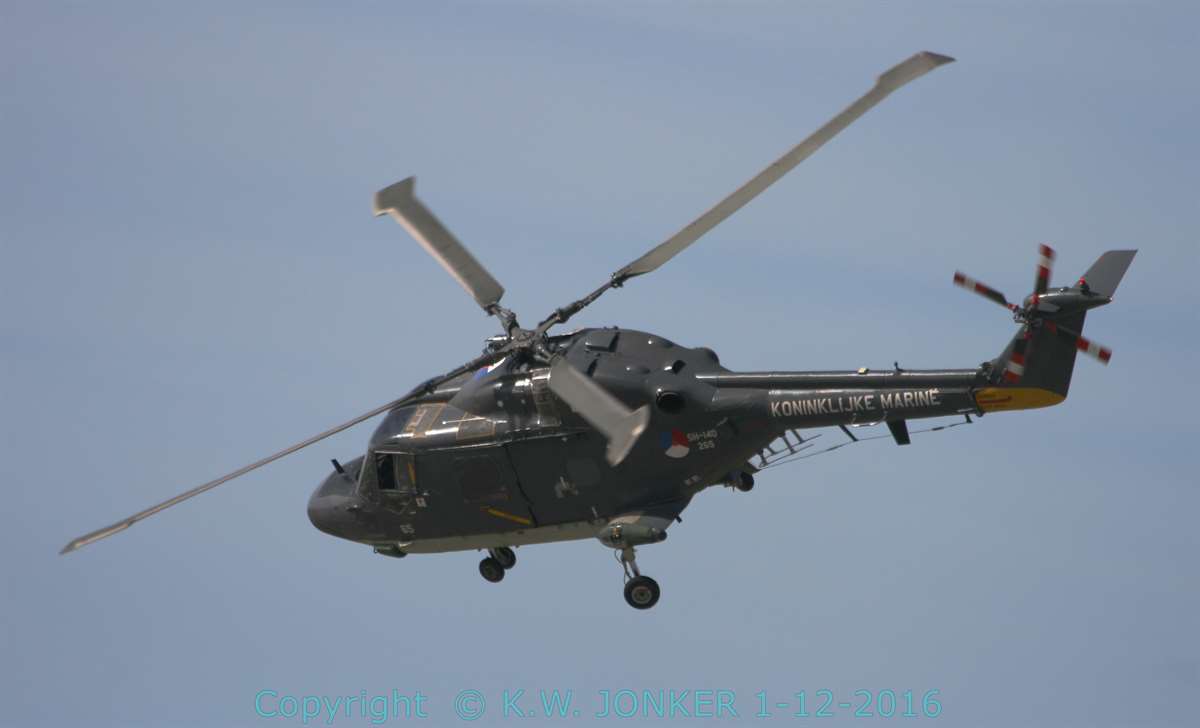
A Westland SH-14D, 265 photographed, September 2007 at naval air station De Kooy.
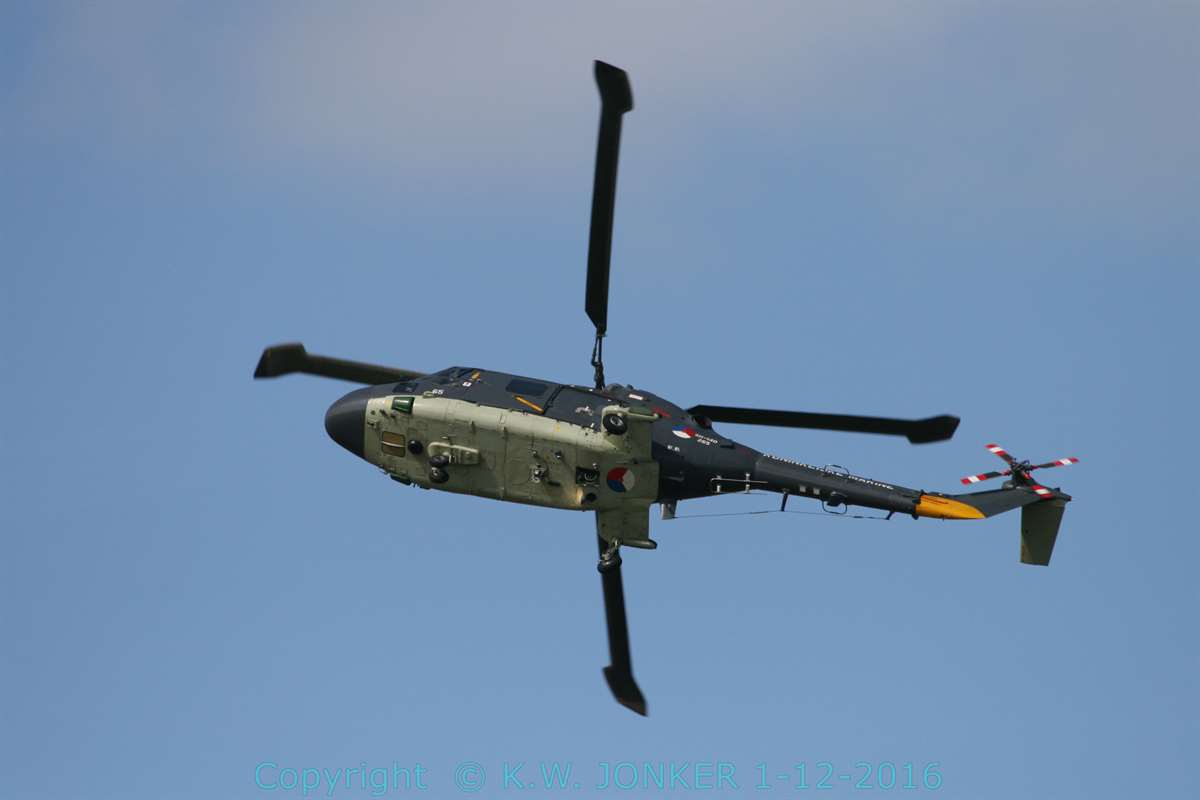
A Westland SH-14D, 265 photographed, September 2007 at naval air station De Kooy.
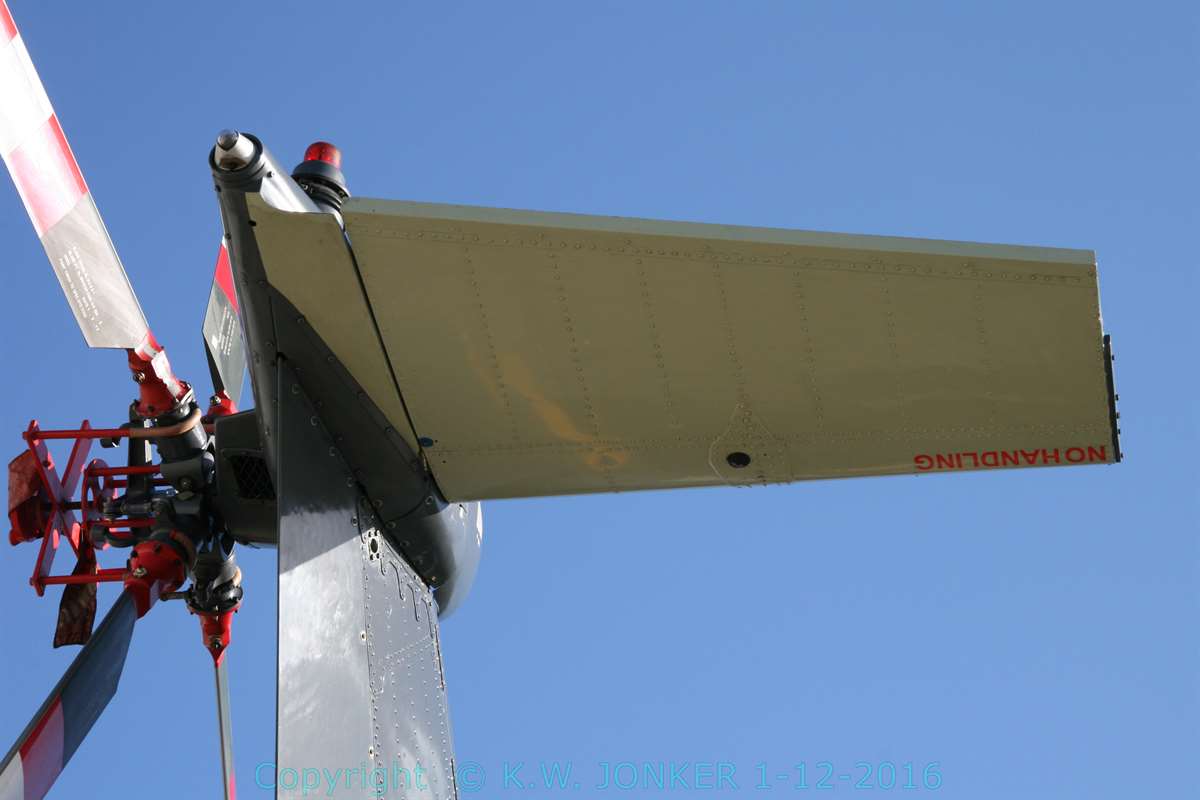
The modified tail of a Westland SH-14D photographed, September 2007 at naval air station De Kooy.
MidLife Modernization (MLM).
During the nineties one of Lynxes had reached its technical design lifetime of 7000 flight hours.
The aircraft, Lynx 270 was withdrawn from service and sent to Westland for inspection.
The construction was still in good condition and it underwent major repairs so it could still take another 1000 hours.
Later, six other Lynxes and possibly more, underwent such a MLM, especially since the delivery of the successor of the Lynx, the NH-90 was significantly delayed.
At time of writing (2009), the delivery schedule of the NH-90 is still planned for 2010.
Mid-2008, the Defence Helicopter Command was established in which all of Defence helicopters are housed. This Command is part of the Royal Netherlands Air Force, so now the Westland Lynx is part of the equipment and the Naval Netherlands Air Service was in effect eliminated.
On September 11, 2012 the Dutch Westland Lynx was definitely withdrawn from use, you may check these (Dutch) sites Afscheid Lynx op Facebook and Lynx in Nederlandse dienst
| Serial
Serial
|
UK Serial
UK Serial
|
Constr. nr.
Constr. nr.
|
Date in service
Date in service
|
Date out of service
Date out of service
|
Notes
notes
|
|---|---|---|---|---|---|
| Westland Lynx Mk.25 (UH-14A); squadron 7 | |||||
| 260 | WA003 | G-17-1 | 14-11-1976 | Modified to SH-14D, dd May 1995 | |
| 261 | WA007 | 16-12-1976 | Modified to SH-14D, dd February 1995 | ||
| 262 | WA018 | 01-07-1977 | Modified to SH-14D, dd May 1995 | ||
| 263 | WA020 | G-17-2 | 24-08-1977 | 01-04-1982 | Used by sq 860. Crashed |
| 264 | WA022 | G-17-3 | 22-09-1977 | Modified to SH-14D, dd December 1993 | |
| 265 | WA023 | G-17-4 | 04-11-1977 | Modified to SH-14D, dd May 1995 | |
| Westland Lynx Mk.27 (SH-14B); Used by squadron 860 | |||||
| 266 | WA076 | G-17-20 | 12-09-1979 | Modified to SH-14D, dd July 1993 | |
| 267 | WA086 | 04-12-1979 | Modified to SH-14D, dd May 1995 | ||
| 268 | WA105 | G-17-20 | 21-09-1979 | Modified to SH-14D, dd June 1993 | |
| 269 | WA108 | G-17-5 | 06-11-1979 | Modified to SH-14D, dd May 1995 | |
| 270 | WA112 | 30-11-1979 | 15-12-2006 | Modified to SH-14D, dd May 1995. Withdrawn from use and stored | |
| 271 | WA118 | G-17-22 | 11-12-1979 | Modified to SH-14D, dd February 1995 | |
| 272 | WA124 | G-17-23 | 30-01-1980 | Modified to SH-14D, dd May 1995 | |
| 273 | WA130 | G-17-20 | 05-02-1980 | Modified to SH-14D, dd November 1993 To Aviation Competence Centre at Maastricht-Aachen Airport, part of Leeuwenborgh opleidingen. |
|
| 274 | WA137 | 05-05-1980 | Modified to SH-14D, dd February 1995 | ||
| 275 | WA143 | 01-01-1979 | 31-03-1982 | Crashed | |
| Westland Lynx Mk.81 (SH-14C); Used by Squadron 860 | |||||
| 276 | WA174 | G-17-25 | 10-10-1980 | 15-12-2006 | Modified to SH-14D, dd January 1995. Withdrawn from use and stored |
| 277 | WA194 | G-17-26 | 31-10-1980 | 0-2-2011 | Modified to SH-14D, dd October 1993. Used for evacuation Dutch engineer from Libya. Captured by Libian army. Returned and written off |
| 278 | WA197 | G-17-27 | 31-10-1980 | Modified to SH-14D, dd November 1993 | |
| 279 | WA198 | G-17-28 | 08-01-1981 | Modified to SH-14D, dd May 1995 | |
| 280 | WA206 | G-17-29 | 03-06-1981 | Modified to SH-14D, dd May 1995 | |
| 281 | WA211 | G-17-30 | 12-03-1981 | Modified to SH-14D, dd May 1995 | |
| 282 | WA215 | G-17-31 | 09-04-1981 | 10-11-1998 | Crashed |
| 283 | WA219 | G-17-32 | 09-04-1981 | Modified to SH-14D, January 1995 | |
1/72nd Scale
Kits
- Airfix
- Kit 03054: A model of a Westland Navy Lynx.
- Also released by Heller, kit 80333, with decals for a SH-14 Lynx, 860 squadron RNlNAs
- Building report of the Westland UH-14A Lynx. by M. De Vreeze
- Kit 03025: Westland Lynx AH1.
- Kit 03063: A model of the Westland Navy Lynx Mk 8 [in fact the same kit as mentioned above, but with additions.)
- Check the website of IPMS Nederland for a review.
The door rails are too large and should be much smaller. The best you can do is comparing it with photographs.
Then the front window is too small and should be replaced by a larger one.
Also, cover of the engine exhausts needs to be corrected. The pipes are stabbing too far and the shape of the hull at the back is not quite right.
See the accompanying photos of the model and the SH-14D.
In the middle of the engines is there should a rectangular outlet, there is none in the Airfix kit.
Next the vertical tail section is incorrect in shape, especially the front is too curved in shape and it starts too high. This should be (at scale 1 / 72) 4 mm wide, 1.5 mm high and about 3 mm deep. (Compare this with photographs and drawings).
Finally, the inlets of the Dutch machines is covered with a grid, which is not supplied with the kit.
- Kit 03054: A model of a Westland Navy Lynx.
- Fujimi
- Kit 635105 / 30137: Westland Navy Lynx; this kit is also released with other kit designations.
The Fujimi kit is on some points better than the Airfix, especially regarding the door rails and the front window.
Unfortunately, this hull of the engine exhausts is not correct, it is relatively flat, it should be more curved. I think this is quite difficult to correct.
The outlets are rather poor, the inlets on the other hand appears to be quite good (for a Dutch machine), although these are moulded into the hull.
The vertical part of the tail seems to be quite correct, although the part on which the tail rotor is mounted is somewhat small.
- Kit 635105 / 30137: Westland Navy Lynx; this kit is also released with other kit designations.
- HobbyBoss
- Kit 87236: Westland Lynx HAS2 (Royal Navy. Aeronavale, Kon Marine)Westland Navy Lynx
- Kit 87237: Westland Lynx HAS3 (Royal Navy)
- Kit 87238: Westland Lynx HMA8 (Royal Navy) "Super Lynx"
- Kit 87239: Westland Lynx MK88 (German Navy (Bundesmarine)
- Kit 87240: Westland Lynx MK90 (Danish and Portuguese Navy)
This are several different releases of the same kit. First impressions are rather good. (see www.hobbyboss.com and www.scale-rotors.com for a preview).
- Master Craft
- Kit d-01: Westland Lynx MK1 (Army)
- Plastyk: Several versions of the Westland Lynx. At www.helikitnews.comyou may find a link to several reviews of this kit.
- Kit S-014: Westland Lynx HAS MK2/HAS MK22 (Kon. Marine, Royal Navy)
- Kit S-018: Westland Lynx HMA-8 (Royal Navy)
- Kit S-019: Westland Lynx AH MK7
- Kit S-020: Westland Lynx AH MK1
- Kit S-021: Westland Lynx MK1 Anti-Terrorism
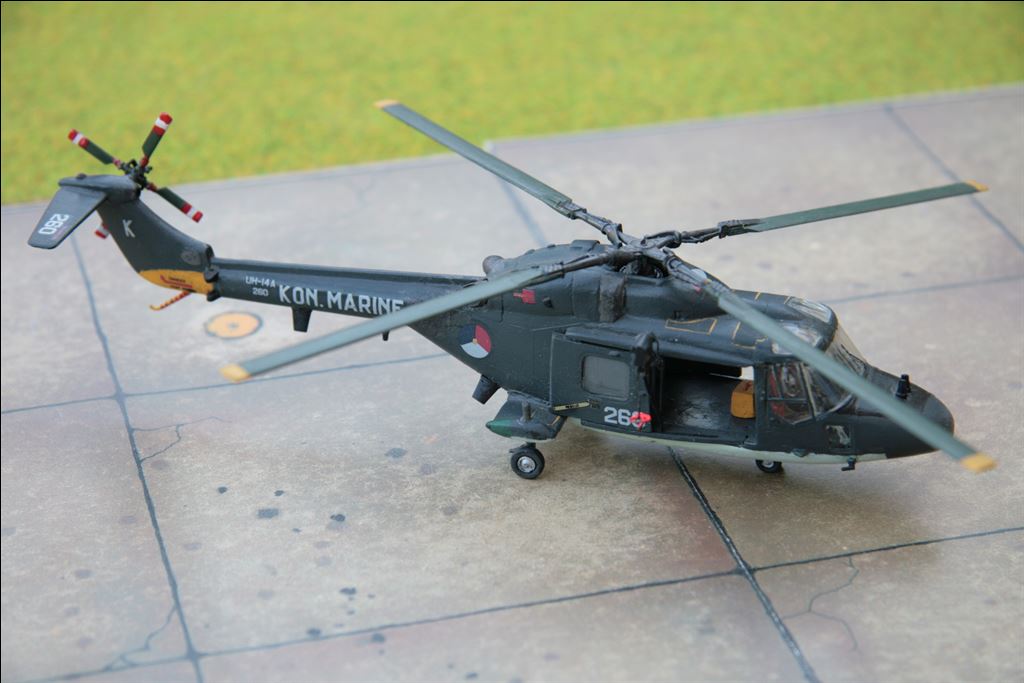
Model of an Airfix Westland UH-14A Lynx built early eighties.
The decals used, were added at the kit at that time. I scratch built the hoist and added some details to the interior.
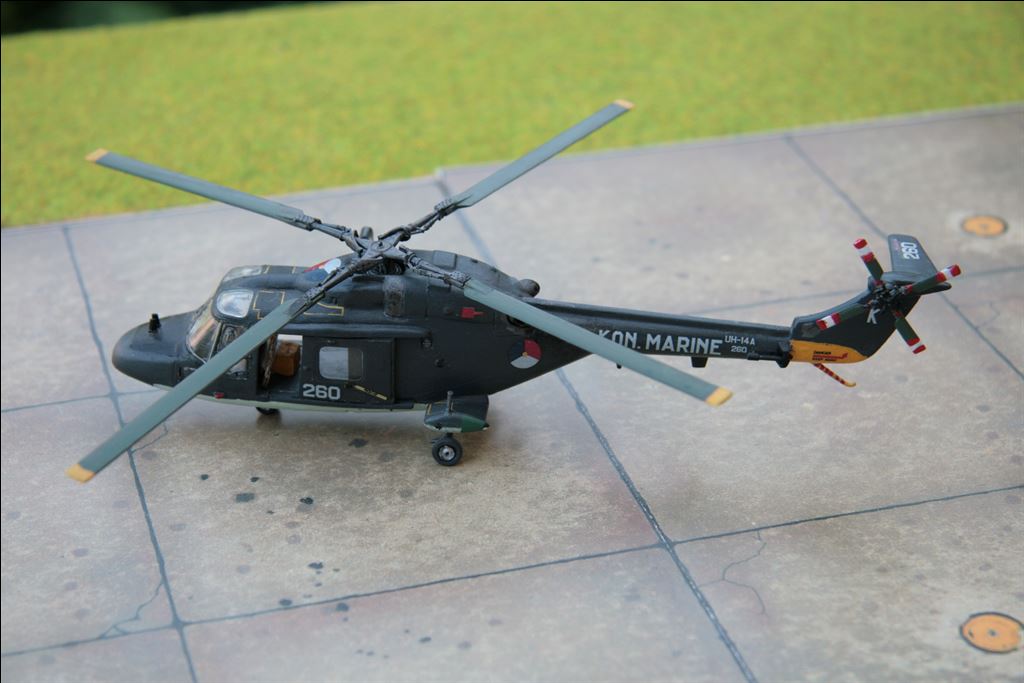
More information regarding the Dutch Lynx
There are also scale models of the Lynx released by Matchbox, in fact a model of the prototype, Frog and Revell (a slightly modified Matchbox-Lynx) been available. These are of lesser quality than the earlier mentioned models.
All scale models are more or less ready to use on a UH-14A, some antennas, hoist needs to be added and some of the interior has to be reworked.
For the SH14B (and SH-14D) a sonar must be made, I haven't done this yet. See the drawings for location and size; it is a hole in the bottom of the hull and with some kind of fairing installed. See the drawings (and photos) for sizes and shape.
The operator sits in a chair on the port side with in front him/her the controls and instrument panel.
When the sonar is not built in, the hole covered with a panel. Chair and instruments are also removed.
Furthermore, the SH-14B has an antenna at the right just in front of the cockpit.
The SH-14C in its original version with MAD, a MAD system has to be built from scratch, see also refer to the accompanying drawings.
The MAD installation was attached to the port side sponson (the right side of the aircraft).
The operator was sitting in the same position as the sonar operator and the equipment was mounted on the same place in the cabin. [At time of writing I have no photographic material of the MAD system can get in MIP No. 4, 1984 (a release of IPMS Netherlands) are two photos available of this installation]
The upgraded versions, designated as SH-14D is more or less based on the SH-14B and the experiences with the Phalanx version.
The most striking since the mid nineties applied BERP blades and the floats attached to the nose.
These attributes are added to the Mk.8 edition of the Airfix Lynx and also to the Hobbyboss Lynx.
Furthermore, the sonar system to be added and for the Airfix kit an extra seat for the sonar operator has to be placed in the cabin.
Furthermore, all kinds of extras are manufactured, such as the additional floats, the antenna on the front of the fuselage as was available on the SH14B, the CHAFF-FLARE installation, the GPS antenna on the tail, a smaller antenna the nose and a similar one on the tail. The left blade antenna on the nose should be omitted.
in case the BERP-rotor are added to your model, the horizontal tail must be shortened. Approximately 454 mm (= 6.3 mm in scale 1/72) was removed and a rim of about 2 cm (= 0.4 mm in scale 1/72, for example a strip of Evergreen 0.25 x 0,5 mm) has to be at the trailing edges.
The RNlNAS has maintained the original tail rotor. The Airfix HAS Mk.8 still has this rotor.
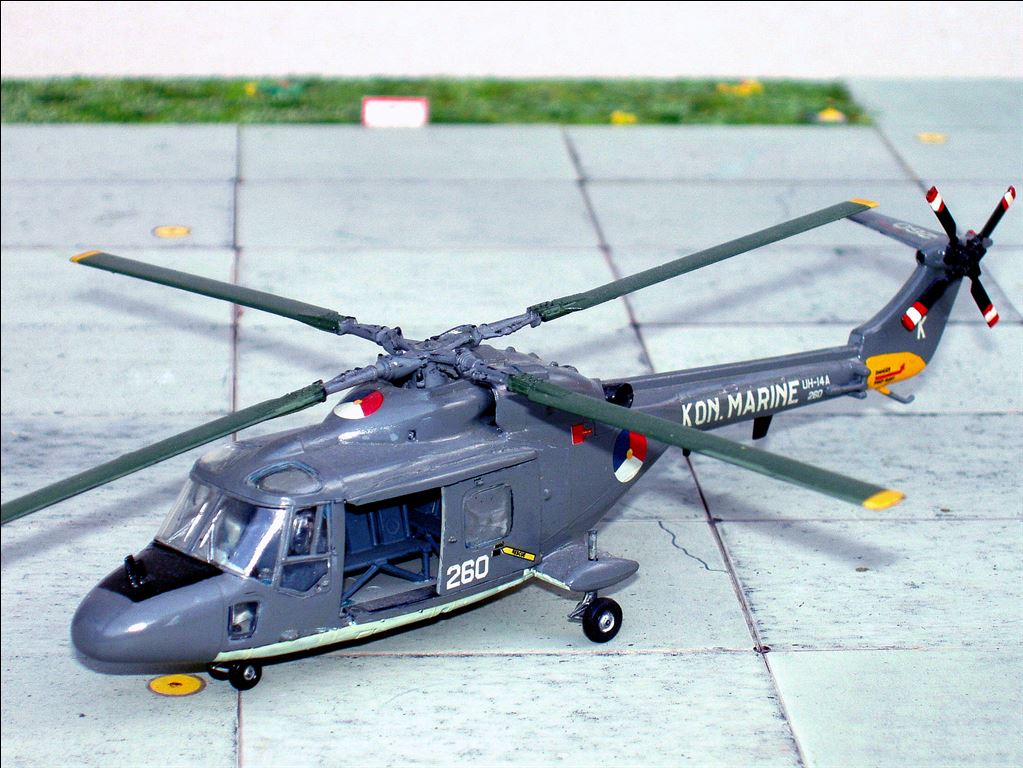

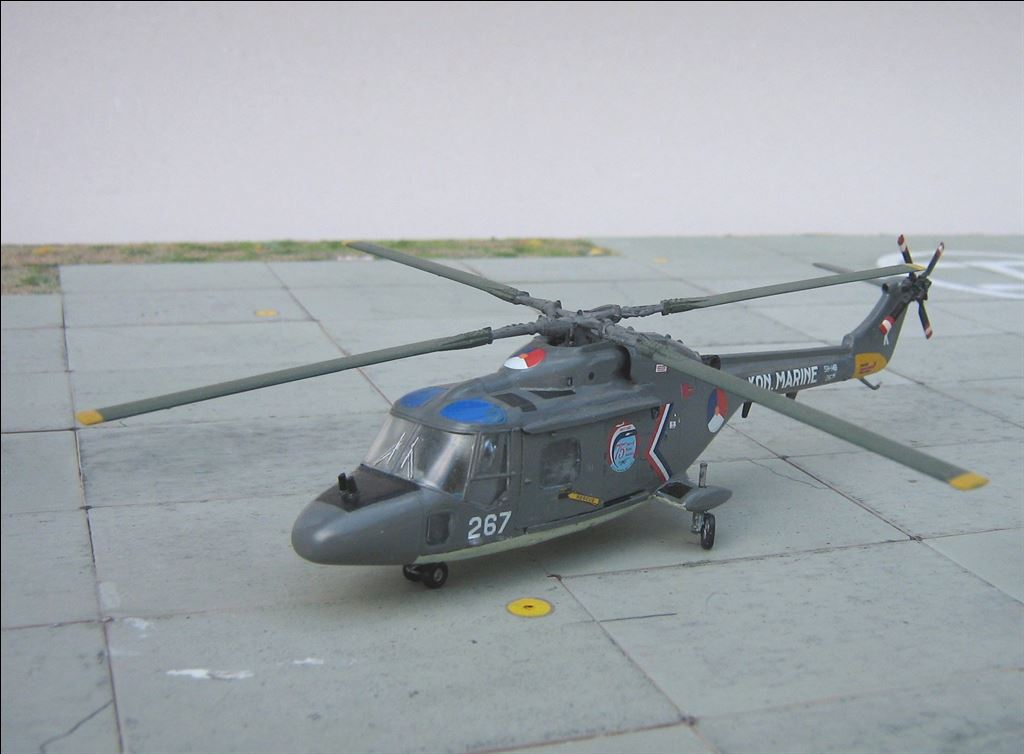

Modelling add-on
- Airwaves
- Set AC72-222: Royal navy Lynx Mk8 Set
- Set AEC7268: Interior set for Lynx HAS.3
- Set SC72114: BERP rotor blades Westland Lynx
- Set AC72-106: Westland Lynx Gulf Conversion (for Airfix HAS5)
- Set SC72107: Westland Lynx HMA8 Conversion (Airfix HAS5)
- Set SC7296: Westland Lynx Weapon Set
- Pavla
- Set U72107: Westland Lynx HAS2 Undercarriage (Hobby Boss)
- Set U72108: Westland Lynx HAS2FN France Undercarriage (Hobby Boss)
- Set U72109: Westland Lynx HAS2 Late type Undercarriage (Hobby Boss)
- Set U72110: Westland Lynx BERP Rotor Blades (Hobby Boss)
- Set s72052: Westland Lynx seats (3) (Hobby Boss)
- Set s72053: Westland Lynx seats - Export (3) (Hobby Boss)
- Set C72084: Westland Lynx HAS2 cockpit detail set (Hobby Boss)
- Duarte models
- Set A7208: Westland Super Lynx conversion
Decals
- Dutch Decal
- Set 72074: Decals for Westland Lynx MLD and aircraft of 32 TFS.
1/48th Scale
Kits
- Airfix
- Kit 50112:Westland Lynx HMA 8.
- Belcher Bits
- Kit xx: See the review at http://www.aircraftresourcecenter.com/gal-fea.htm.
Modelling add-on
- Eduard
- Set E49-629: Detailset Westland Lynx AH7 seatbelts (Airfix)
- Set BIG4985: Detailset Westland Lynx HMA8
- Set FE628: Detailset Westland Lynx AH7 Interior Self Adhesive (Airfix)
- Set E49-628: Detailset Westland Lynx AH7 Interior Self adhesive (Airfix)
- Set E48-759: Detailset Westland Lynx AH7 Exterior (Airfix)
- Set FE625: Detailset Westland Lynx MK88 Interior Self Adhesive (Airfix)
- Set E49-625: Detailset Westland Lynx MK88 Interior Self Adhesive (Airfix)
- Set E49-624: Detailset Westland Lynx MK88 Seatbelts (Airfix)
- Set E48-752: Detailset Westland Lynx MK88 Exterior (Airfix)
- Set E49-623: Detailset Westland Lynx HMA8 Seatbelts Self Adhesive (Airfix)
- Set E49-613: Detailset Westland Lynx HMA8 Interior Self Adhesive (Airfix)
- Rotorcraft
- Set 48006: Westland Lynx HAS3 Gulf Killer conversion set (Airfix)
- Set 48005: Westland Lynx HAS2/3 conversion set (Airfix) Also for Dutch Variant
- Set 48002: Westland Lynx AH1 conversion set (Airfix)
- Set 48003: Westland Lynx HAS2/3 conversion set (Airfix) Also for Dutch Variant
- Set 48004: Westland Lynx HMA8 stub wing replacement for current Lynx (Airfix)
Decals
- Dutch Decal
- Set 48048: Decals for Westland Lynx (UH14A & SH14D) Marine Luchtvaart Dienst.
Upon delivery, the Dutch Lynx was in the usual colours Extra Dark Sea Grey over Sky.
Early eighties there was (in the Netherlands) much discussion about the colour Extra Dark Sea Grey. The MIP No. 1 of 1984 (an IPMS Netherlands release) stated that this would be Humbrol Authentic Colour HB-7.
I added this on my first (and thus far only) Lynx model. But at that time I was training at the NAM gas treatment facilities in Den Helder; Naval Air station De Kooy was situated just on the other side of the canal. I saw the Lynx passing by every day and saw immediately saw that HB-7 was far too light and too grey.
The aircraft were much darker and had also a sort of bluish grey applied. Our fellow modellers of the NVM had a similar discussion at that time, about the colours of the Dutch Lockheed P3-C Orion. An naval employee compared the used colour with different Humbrol paints and concluded Humbrol HF-5, Blue Gris Clair Foncé, was the best match.
This colour I applied to my model and I still think the result much more realistic. As the Humbrol Authentic series is discontinued for many years, a good replacement would be Humbrol 79, matt Blue Gray, according to Humbrol. Because of adding a protective varnish to your model, the taint might become somewhat darker. If one wishes you first mix the colour paint with some white, there are some description related to the scale of your model.
The rotor Head is grey. Main and tail rotor blades are olive green (BS831C 641 = Sikkens 46056); tips of the original blades were yellow. Also two yellow stripes had been added to the main rotor blades. The tips of the tail rotor blades are bright red, white and bright red.
The BERP blades have a different colour, merely grey-green. Alas I don't have any information about this colour.
Further the SH-14D is sprayed with a more greyish colour than the original Lynx, though officially the colour should be exactly the same. (perhaps a protective varnish was used which caused the somewhat blueish tint of the original machines).
The chairs are grey. cushion are orange, blue seat belts an often a yellow coat on the seat. The bucket seat has a grey frame with blue seats and seat belts. The frame of the sonar installation is also light grey.
| Scheme | Colour name | FS-number | BS-number | Humbrol | XtraColor | Vallejo ModelColor | Vallejo ModelAir | Hataka | |
|---|---|---|---|---|---|---|---|---|---|
| Standard #1 | Uppersides | Extra Dark Sea Grey | ~6099 | BS:640 | 123 / 106 | X-5 / X-376 | 70.866 | 71.110 | ~140 |
| Undersides | Sky | - | BS:210 | 90 | X004 / X130 | - | 71.302 | ~026 | |
| Rotor blades | Dark green | - | BS:641 | 163 | X001 | 70892 | 71.013 | ~143 | |
Check www.paint4models.com for an extensive conversion table with lots of colour and paint systems.
Serial overview
Initially the serial was applied with large white lettering on the cabin door and , accompanied with the type designation on the tail in a smaller type of lettering.
Mid eighties the position and size of the serials was changed. The serial was moved to a position just n the fuselage in front of the cabin door.
Several years later the roundel was reduced in size to about two-third of the original size, the type designation and serial were moved from tail to a position next to the roundel on the fuselage and the serial on the nose was also reduced in sized an restricted to the last two digits. Also the serial was removed from the horizontal tail and the designation Kon. Marine on the tail boom was replaced with Koninklijke Marine.
Initially the type designation was applied in black, by this caused many problems with reading on the platforms aboard the ships, so soon the colour was changed to white again.
Tail codes
Until early nineties the Lynxes had also a white code on the tail. This code varied and depended on the location where the Lynx was bases, e.g. K was for air base De Kooy; KN meant M-frigate Kortenaer.
The Lynx stationed aboard a ship often had some kind of cartoons applied on the nose. This nose art were related to the Technical Squadrons, which maintained the Lynx. In case the individual Lynx was stationed to another ship, the nose cone was replaced. later this was strictly forbidden and the art was added to the sliding cabin doors, which could be easily changed. Check your references if your want to add some of this art to your scale model.
A nice photo of a Dutch UN Lynx can be found here.
Literature.
| Zestig jaar Marineluchtvaartdienst in Beeld. | Hugo Hooftman | pag. 154 - 155 | 1977 | Uitgever Europese Bibliotheek, Zaltbommel |
| Dutch Military Aviation 1945-1978 | Paul A. Jackson | pag. 111; 119 | 1978 | Uitgever Midland Countries Publications, Leicester |
| Nederlandse Marinevliegtuigen | Thijs Postma & Nico Geldhof | Pag. 76 | 1978 | Uitgever Omniboek, 's Gravenhage |
| AVIA; 41e jaargang nummer 1: De Westland Lynx, van alle markten thuis | Bart van der Klaauw | pag. 18 - 25 | 1982 | Uitgevers Wyt. Rotterdam |
| AVIA; 42e jaargang nummer 10: Vliegtuigsquadron 860 anno 1983: 'Never a dull moment" | nico Geldhof | Pag. 348 - 351 | 1983 | Uitgevers Wyt, Rotterdam |
| Modelbouw in Plastic jaargang 13, nummer 4: De Marineluchtvaartdienst LYNX. | Fred Bachofner | Pag. 74 - 81 | 1984 | Uitgever I.P.M.S. Nederland |
| Luchtvaartwereld; 4e jaargang nummer 7/8: VSQ 7 | Nico Geldhof | Pag. 203 - 206 | 1987 | Uitgeverij Ten Brink, Meppel |
| 70 Jaar Marine-LuchtvaartDienst | Nico Geldhof | pag. 159 - 161 | 1987 | Uitgeverij Eisma b.v., Leeuwarden |
| Luchtvaartwereld; 7e jaargang nummer 6: Lynx-helikopter tegen onderzeeërs. | Hans Heerkens | pag. 174 - 177 | 1990 | Uitgeverij Ten Brink, Meppel |
| Luchtvaart; 12e jaargang nummer 9: ingezonden brief | pag. 37 | 1995 | Uitgeverij Ten Brink, Meppel | |
| Luchtvaart; 12e jaargang nummer 9: Groep Helikopters dient de vloot | Nico Geldhof | pag. 21 - 23 | 1995 | Uitgeverij Ten Brink, Meppel |
| Camouflage en Kentekens | J.Greuter e.a. | 1997 | Bonneville – Bergen (NH) | |
| 85 JAAR Marineluchtvaartdienst in beeld: Van Farman tot NH 90 Helikopter | Peter Korbee | Pag. 148 - 149; 150 - 151 | 2002 | Uitgever Korbee MLD Promotie, Valkenburg |
| Marinevliegkamp De Kooy | W.F. Visee | Pag. 130 - 145 | ||
| Fuyll Stop: Westland Lynxx; De Kooy | T. Bouwmeester e.a. | pag. 14 - 30 | 12-2005 |
Websites.
Special thanks to mr. Peter Booy, Seraya Prudon, Maarten Schönfeld and J.Schuurman and many others for providing me with lots of information about the (Dutch) Westland Lynx.

